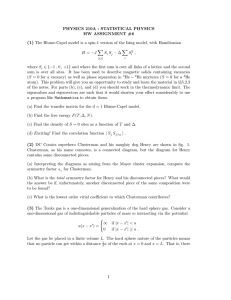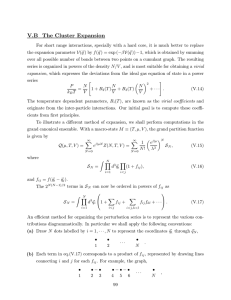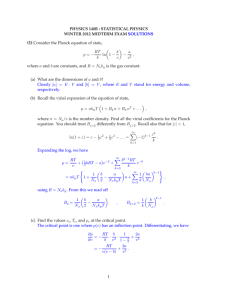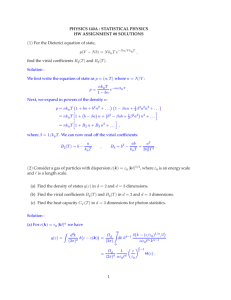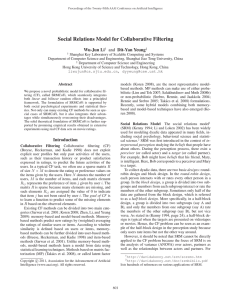6 Interacting Classical Systems : Summary
advertisement
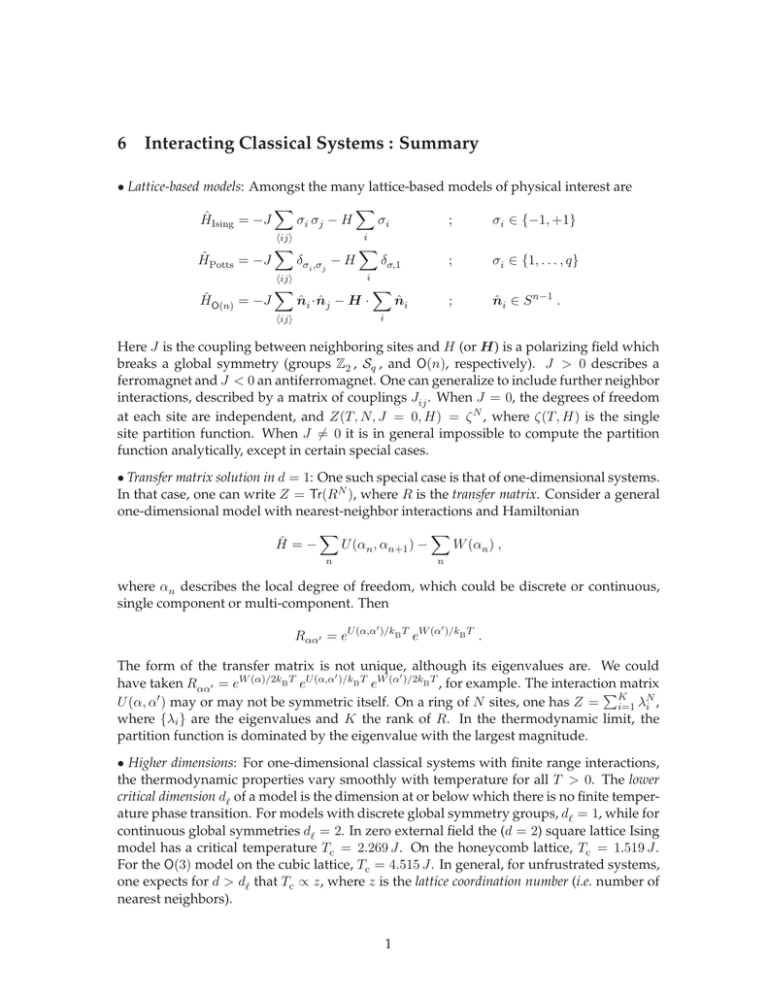
6 Interacting Classical Systems : Summary
• Lattice-based models: Amongst the many lattice-based models of physical interest are
X
X
ĤIsing = −J
σi σj − H
σi
;
σi ∈ {−1, +1}
ĤPotts = −J
hiji
i
X
X
δσi ,σj − H
ĤO(n) = −J
;
σi ∈ {1, . . . , q}
;
n̂i ∈ S n−1 .
i
hiji
X
δσ,1
n̂i · n̂j − H ·
X
n̂i
i
hiji
Here J is the coupling between neighboring sites and H (or H) is a polarizing field which
breaks a global symmetry (groups Z2 , Sq , and O(n), respectively). J > 0 describes a
ferromagnet and J < 0 an antiferromagnet. One can generalize to include further neighbor
interactions, described by a matrix of couplings Jij . When J = 0, the degrees of freedom
at each site are independent, and Z(T, N, J = 0, H) = ζ N , where ζ(T, H) is the single
site partition function. When J 6= 0 it is in general impossible to compute the partition
function analytically, except in certain special cases.
• Transfer matrix solution in d = 1: One such special case is that of one-dimensional systems.
In that case, one can write Z = Tr(RN ), where R is the transfer matrix. Consider a general
one-dimensional model with nearest-neighbor interactions and Hamiltonian
X
X
W (αn ) ,
U (αn , αn+1 ) −
Ĥ = −
n
n
where αn describes the local degree of freedom, which could be discrete or continuous,
single component or multi-component. Then
′
′
Rαα′ = eU (α,α )/kB T eW (α )/kB T .
The form of the transfer matrix is not unique, although its eigenvalues are. We could
′
′
have taken Rαα′ = eW (α)/2kB T eU (α,α )/kB T eW (α )/2kB T , for example. The interaction matrix
P
N
U (α, α′ ) may or may not be symmetric itself. On a ring of N sites, one has Z = K
i=1 λi ,
where {λi } are the eigenvalues and K the rank of R. In the thermodynamic limit, the
partition function is dominated by the eigenvalue with the largest magnitude.
• Higher dimensions: For one-dimensional classical systems with finite range interactions,
the thermodynamic properties vary smoothly with temperature for all T > 0. The lower
critical dimension dℓ of a model is the dimension at or below which there is no finite temperature phase transition. For models with discrete global symmetry groups, dℓ = 1, while for
continuous global symmetries dℓ = 2. In zero external field the (d = 2) square lattice Ising
model has a critical temperature Tc = 2.269 J. On the honeycomb lattice, Tc = 1.519 J.
For the O(3) model on the cubic lattice, Tc = 4.515 J. In general, for unfrustrated systems,
one expects for d > dℓ that Tc ∝ z, where z is the lattice coordination number (i.e. number of
nearest neighbors).
1
• Nonideal classical gases: For Ĥ =
d
QN (T, V ), where
λ−N
T
p2i
i=1 2m
PN
1
QN (T, V ) =
N!
Z
+
d
d x1 · · ·
Z
P
u |xi − xj | , one has Z(T, V, N ) =
ddxN
Y
i<j
e−u(rij )/kB T
i<j
is the configuration integral. For the one-dimensional Tonks gas of N hard rods of length a
confined to the region x ∈ [0, L], one finds QN (T, L) = (L − N a)N , whence the equation of
state p = nkB T /(1 − na). For more complicated interactions, or in higher dimensions, the
configuration integral is analytically intractable.
• Mayer cluster expansion: Writing the Mayer function fij ≡ e−uij /kB T − 1, and assuming
R d
d r f (r) is finite, one can expand the pressure p(T, z) and n(T, z) as power series in the
fugacity z = exp(µ/kB T ), viz.
X
nγ
zλ−d
p/kB T =
bγ
T
γ
n=
X
nγ zλ−d
T
γ
nγ
bγ .
The sum is over unlabeled connected clusters γ, and nγ is the number of vertices in γ. The
cluster integral bγ (T ) is obtained by assigning labels {1, . . . nγ } to all the vertices, and computing
Z
γ
Y
1 1
d
d
·
fij ,
d x1 · · · d xnγ
bγ (T ) ≡
sγ V
i<j
where fij appears in the product if there is a link between vertices i and j. sγ is the symmetry factor of the cluster, defined to be the number of elements from the symmetric group
Q
Snγ which, acting on the labels, would leave the product γi<j fij invariant. Translational
invariance implies bγ (T ) ∝ V 0 . One then inverts n(T, z) to obtain z(T, n), and inserting the
result into the equation for p(T, z) one obtains the virial expansion of the equation of state,
n
o
p = nkB T 1 + B2 (T ) n + B3 (T ) n2 + . . . .
By definition, a cluster consisting of a single site has b• = 1.
• Liquids: In the ordinary canonical ensemble,
P (x1 , . . . , xN ) = Q−1
N ·
1 −βW (x1 , ... , x )
N ,
e
N!
where W is the total potential energy, and QN is the configuration integral,
Z
Z
1
d
QN (T, V ) =
d x1 · · · ddxN e−βW (x1 , ... , xN ) .
N!
2
We can use P , or its grand canonical generalization, to compute thermal averages, such as
the average local density
X
δ(r − xi )
n1 (r) =
Zi
d
Z
= N d x2 · · · ddxN P (r, x2 , . . . , xN )
and the two particle density matrix, two-particle density matrix n2 (r1 , r2 ) is defined by
X
n2 (r1 , r2 ) =
δ(r1 − xi ) δ(r2 − xj )
i6=j
Z
Z
d
= N (N − 1) d x3 · · · ddxN P (r1 , r2 , x3 , . . . , xN ) .
• Pair distribution function: For translationally invariant simple fluids consisting of identical point particles interacting by a two-body central potential u(r), the thermodynamic
properties follow from the behavior of the pair distribution function (pdf),
g(r) =
1 X
δ(r
−
x
+
x
)
,
i
j
V n2
i6=j
where V is the total volume and n = N/V the average density. The average energy per
particle is then
Z∞
hEi
3
= 2 kB T + 2πn dr r 2 g(r) u(r) .
ε(n, T ) =
N
0
Here g(r) is implicitly dependent on n and
R T as well In the grand canonical ensemble, the
pdf satisfies the compressibility sum rule, d3r g(r) − 1 = kB T κT − n−1 , where κT is the
isothermal compressibility. Note g(∞) = 1. The pdf also implies the virial equation of state,
Z∞
p = nkB T − 23 πn2 dr r 3 g(r) u′ (r) .
0
• Scattering: Scattering experiments are sensitive to momentum transfer ~q and energy
transfer ~ω, and allow determination of the dynamic structure factor
1
S(q, ω) =
N
Z∞
X iq·x (0) −iq·x (t) l′
dt eiωt
e l e
T
l,l′
−∞
=
N
X X
2
2π~ X
j
Pi
e−iq·xl i δ(Ej − Ei + ~ω) ,
N
i
j
l=1
3
where | i i and | j i are (quantum) states of the system being studied, and Pi is the equilibrium probability for state i.1 Integrating over all frequency, one obtains the static structure
factor,
Z∞
1 X iq·(xl −x ′ ) dω
l
S(q, ω) =
e
2π
N ′
l,l
−∞
Z
= N δq,0 + 1 + n ddr e−iq·r g(r) − 1 .
S(q) =
• Theories of fluid structure – The BBGKY hierarchy is set of coupled integrodifferential
equations relating k- and (k + 1)-particle
distribution functions. In order to make
progress, a truncation must be performed,
expressing higher order distributions in
terms of lower order ones. This results in
various theories of fluids, known by their
defining equations for the pdf g(r). Examples include the Born-Green-Yvon equation, the Percus-Yevick equation, the hypernetted chains equation, the Ornstein- Figure 1: Comparison of the static structure facZernike approximation, etc. Except in the tor as determined by neutron scattering work of
simplest cases (such as the OZ approxima- J. L. Yarnell et al., Phys. Rev. A 7, 2130 (1973) with
tion), these equations must be solved nu- molecular dynamics calculations by Verlet (1967)
for a Lennard-Jones fluid.
merically. OZ approximation deserves special mention. There we write S(q) ≈ (R/ξ)21+R2 q2 for small q, where ξ(T ) is the correlation
length and R(T ) is related to the range of interactions.
• Debye-Hückel theory – Due to the long-ranged nature of the Coulomb interaction, the
Mayer function decays so slowly as r → ∞ that it is not integrable, so the virial expansion
is problematic. Progress can be made by a self-consistent mean field approach. For a system consisting of charges ±e, one assumes a local electrostatic potential φ(r). Boltzmann
statistics then gives a charge density
e φ(r)/kB T
−e φ(r)/kB T
,
− eλ−d
ρ(r) = eλ−d
− z− e
+ z+ e
where λ± and z± are the thermal de Broglie wavelengths and fugacities for the + and −
−d
species. Assuming overall charge neutrality at infinity, one has λ−d
+ z+ = λ− z− = n∞ ,
and we have ρ(r) = −2en∞ sinh e φ(r)/kB T . The local potential is then determined selfconsistently, using Poisson’s equation:
∇2 φ = 8πen∞ sinh(eφ/kB T ) − 4πρext .
1
In practice, what is measured is S(q, ω) convolved with spatial and energy resolution filters appropriate
to the measuring apparatus.
4
If eφ ≪ kB T , we can expand the sinh function to obtain ∇2 φ = κ2D φ − 4πρext , where the
Debye screening wavevector is κD = (8πn∞ e2 /kB T )1/2 . The self-consistent potential arising
from a point charge ρext (r) = Q δ(r) is then of the Yukawa form φ(r) = Q exp(−κD r)/r in
three space dimensions.
• Thomas-Fermi screening – In an electron gas with kB T ≪ εF , we may take T = 0. If the
~2 k 2 (r)
F
− e φ(r), and local electron number density
Fermi energy is constant, we write εF = 2m
3
2
is n(r) = kF (r)/3π . Assuming a compensating smeared positive charge background ρ+ =
e n∞ , Poisson’s equation takes the form
(
)
eφ(r) 3/2
2
∇ φ = 4πe n∞ ·
− 1 − 4πρext (r) .
1+
εF
If eφ ≪ εF , we expand in the presence of external sources to obtain ∇2 φ = κ2TF φ − 4πρext ,
where κTF = (6πn∞ e2 /εF )1/2 is the Thomas-Fermi screening wavevector. In metals, where the
electron dispersion is a more general function of crystal momentum, the density response
to a local potential φ(r) is δn(r) = e φ(r) g(εF ) to lowest
order, where g(εF ) is the density
p
2
of states at the Fermi energy. One then finds κTF = 4πe g(εF ).
5
